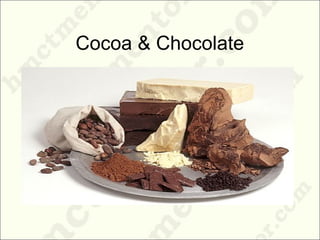The document provides a history of cocoa and chocolate production. It begins with the Aztecs consuming a drink called "chocolatl" made from roasted cocoa beans. Over time, methods were developed to press cocoa butter from the beans and produce chocolate in solid forms. In the 1800s, milk chocolate was invented using cocoa, sugar, and milk. Mass production helped make chocolate affordable and popular globally. The document also details cocoa cultivation, processing of the beans, and methods for tempering and working with chocolate.



























